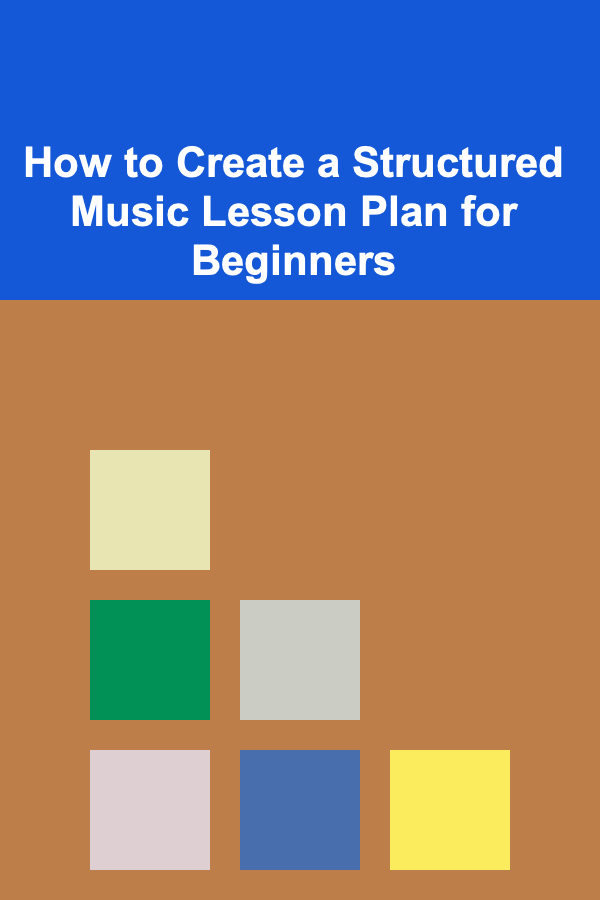
How to Create a Structured Music Lesson Plan for Beginners
ebook include PDF & Audio bundle (Micro Guide)
$12.99$9.99
Limited Time Offer! Order within the next:

Teaching music to beginners is a rewarding yet challenging experience. A well-structured music lesson plan is key to helping students grasp foundational skills, develop a love for music, and advance in their musical journey. In this guide, we'll explore the essential components of a music lesson plan for beginners and provide actionable steps to create a lesson that is organized, engaging, and effective.
Understand the Goal of Your Lesson
Before you start planning any lesson, it's essential to have a clear understanding of the ultimate goal. For beginners, the focus should be on developing basic skills, such as understanding rhythm, learning notes, and getting familiar with the instrument or voice. Your goal is to provide students with a solid foundation while keeping them engaged and motivated to continue their musical education.
Key Considerations:
- Skill Level: Tailor the lesson to the beginner level, meaning the student has little to no experience with the instrument, voice, or music theory.
- Confidence Building: Create an environment where students feel comfortable making mistakes and asking questions. Music should be fun and accessible, not intimidating.
- Interest in Music: Ensure the lesson includes elements that engage and excite the student about learning. Keep the atmosphere fun while reinforcing structure and discipline.
Specific Goals for a Beginner Lesson:
- Familiarize students with the basic music terminology (e.g., tempo, rhythm, dynamics).
- Teach fundamental music theory, such as notes on a staff or chord progressions.
- Introduce proper posture and technique for the instrument or voice.
- Encourage the development of ear training, such as identifying different pitches or rhythms.
Structure Your Lesson Plan with Clear Phases
A well-structured lesson helps maintain focus and flow. Below is a breakdown of an effective beginner lesson plan:
1. Warm-Up and Greeting (5-10 minutes)
The beginning of your lesson sets the tone for the rest of the session. Start by greeting the student warmly and engaging them with a brief warm-up activity. This phase allows students to settle in and mentally prepare for the lesson ahead.
Warm-Up Ideas:
- Breathing exercises (for vocalists or wind instrument players) to promote relaxation and breath control.
- Simple finger or hand exercises (for instrumentalists) to loosen up and improve motor skills.
- Rhythm clapping or tapping to engage the student in the lesson's focus.
2. Review Previous Material (5-10 minutes)
If the student has been through prior lessons, use this phase to briefly review material from the previous session. This not only reinforces concepts but also boosts the student's confidence as they recall what they've learned.
Example Review Questions:
- "Do you remember the notes we covered last time?"
- "Can you play the scale we practiced last week?"
- "What was the rhythm pattern we learned?"
3. Introduction to New Material (15-20 minutes)
This is the core of the lesson where you introduce new concepts or techniques. For beginners, the material should be simple and progressive, building from what the student has already learned. Keep the material manageable, and break it down into small, digestible segments.
Steps for Introducing New Material:
- Explain: Clearly explain the concept in simple language. Avoid jargon unless you are certain the student understands it. For example, when teaching notes, you could say, "This is middle C, and it's one of the first notes you will learn because it is in the center of the piano keyboard."
- Demonstrate: Play or sing the concept yourself so the student can hear how it should sound. A visual and auditory demonstration helps reinforce understanding.
- Practice Together: Guide the student through the concept by playing or singing together. Give them plenty of time to process and adjust their technique.
- Encourage Independence: Gradually let the student try the concept on their own, offering feedback as needed.
Example: Introducing a Simple Scale on Piano
- Explain the C major scale (C-D-E-F-G-A-B-C) and its relationship to the white keys on the keyboard.
- Demonstrate how to play it, focusing on proper finger positioning and smooth transitions between notes.
- Have the student try it with you, giving them time to practice slowly.
- Allow the student to play it on their own while providing feedback on finger technique, hand posture, and rhythm.
4. Application and Practice (15-20 minutes)
Once the new material is introduced, it's time to apply it in a practical context. Allow students to practice the new material in different ways, applying it to real musical situations. This phase reinforces the new concepts and helps students integrate them into their overall understanding of music.
Application Ideas:
- Song Application: Have the student apply the scale or rhythm to a simple song. For example, if you're teaching piano, guide them through a basic melody using the notes from the C major scale.
- Improvisation: Encourage students to experiment with the new concept by improvising simple melodies or rhythms.
5. Cool Down and Recap (5-10 minutes)
As the lesson nears its end, it's important to recap what was covered and offer a cool-down activity. This phase helps the student process the material and gives them a chance to ask any remaining questions.
Recap Activities:
- Question Time: Ask the student to explain or demonstrate what they've learned. This helps reinforce their understanding and gives them an opportunity to reflect.
- Review Key Points: Recap the key concepts of the lesson in a clear and concise manner, such as, "Today we learned the C major scale and how to play it on the piano. You did great at keeping a steady rhythm!"
- Set Homework: Assign a short practice task for the student to work on before the next lesson. Be sure the homework is manageable and aligned with the day's lesson.
Example Homework:
- "Practice the C major scale for 5 minutes every day."
- "Try to play a simple melody using the notes from the scale."
Incorporate Active Learning and Engagement
For beginners, it's essential to keep the lesson engaging. Active learning is a proven way to maintain student interest and deepen their understanding. Below are several strategies to make your lessons more interactive:
1. Use Visual Aids
- Sheet music: Display sheet music on a whiteboard or screen to help students visualize what they're learning.
- Flashcards: Use flashcards with notes, rhythms, or terms to help reinforce concepts in a fun, interactive way.
- Diagrams: For instrumental lessons, diagrams showing hand positions or fingerings can be extremely helpful.
2. Interactive Games
- Rhythm clapping games: Challenge students to clap rhythms you play, increasing complexity as they improve.
- Note-naming races: Have students race to name notes on the staff, or play a note and have them identify it by ear.
3. Encourage Active Listening
- For vocalists or instrumentalists, teach them to listen carefully to the tones, rhythms, and dynamics in music. Active listening develops their ear for music, which is fundamental for any musician.
Personalize the Lesson Plan
Every student is unique, so it's important to tailor each lesson to their specific interests, strengths, and areas of growth. For example, if you have a student who loves pop music, try incorporating simple versions of popular songs into their lessons to maintain motivation. Personalization helps the student connect with the material and fosters a deeper interest in learning.
Track Progress and Provide Feedback
Consistent feedback is a critical part of any beginner's development. Regularly assess the student's progress and offer constructive feedback. Celebrate their achievements, no matter how small, to encourage them to continue improving.
Feedback Tips:
- Focus on the positive: Highlight what the student did well before pointing out areas for improvement.
- Offer specific guidance: Instead of saying, "Play better," offer specific suggestions, such as, "Try playing the notes more evenly by counting out loud."
- Be patient: Beginners often need time to absorb new information, so provide encouragement and remind them that progress takes time.
Conclusion
Creating a structured music lesson plan for beginners requires careful thought and preparation. By setting clear goals, breaking down the lesson into manageable phases, incorporating engaging activities, and offering personalized feedback, you can create a learning environment that fosters growth, creativity, and a love of music. Whether you're teaching an instrument, voice, or music theory, a well-structured lesson plan will ensure your students develop the skills they need while enjoying the process of learning music.

How to Make the Most of Your Outdoor Storage Options
Read More
How To Understand the Psychology of Game Design
Read More
How to Use Email Marketing to Increase Sales Conversions
Read More
How to Use Under-Cabinet Storage in the Kitchen
Read More
How to Use Breath as Your Anchor in Meditation
Read More
How to Build a Minimum Viable Product (MVP)
Read MoreOther Products

How to Make the Most of Your Outdoor Storage Options
Read More
How To Understand the Psychology of Game Design
Read More
How to Use Email Marketing to Increase Sales Conversions
Read More
How to Use Under-Cabinet Storage in the Kitchen
Read More
How to Use Breath as Your Anchor in Meditation
Read More